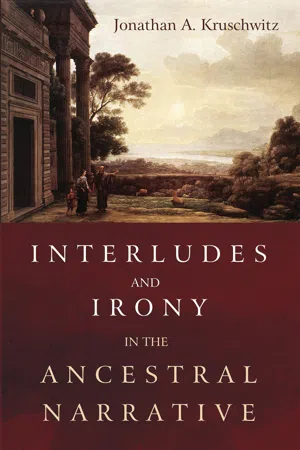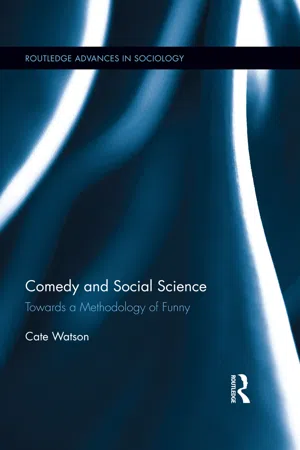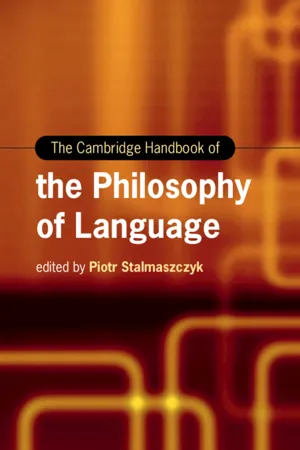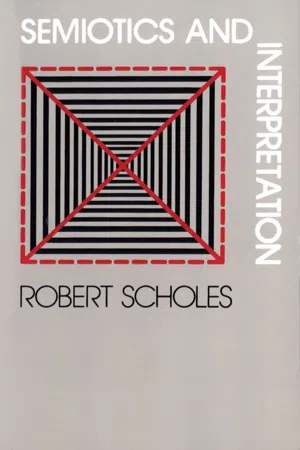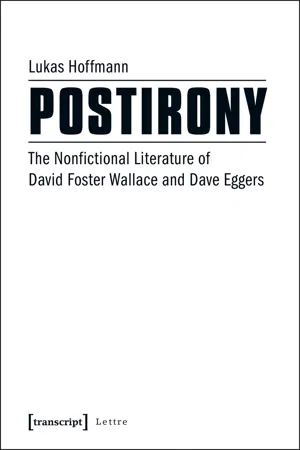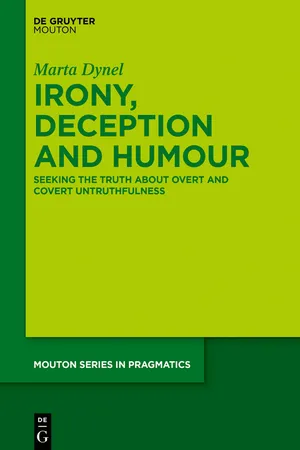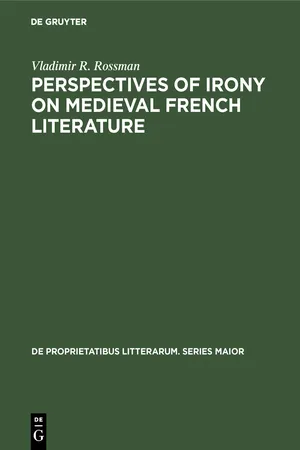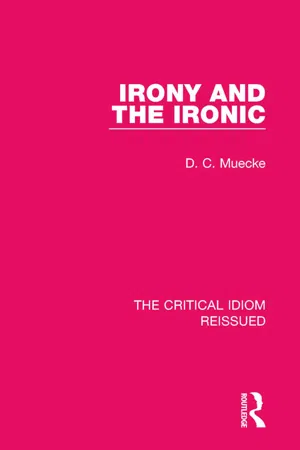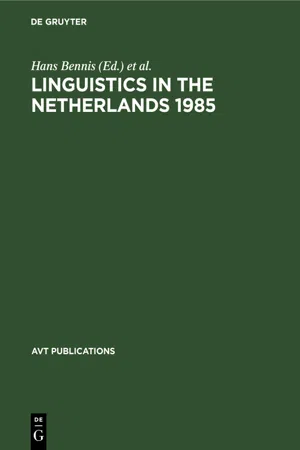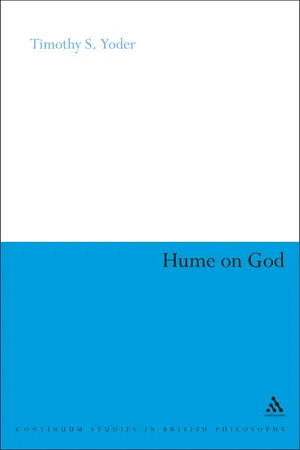Literature
Irony
Irony in literature refers to a contrast between what is expected and what actually occurs. It can manifest in various forms, such as verbal irony, situational irony, and dramatic irony. Verbal irony involves saying one thing but meaning another, while situational irony occurs when the outcome is different from what was anticipated. Dramatic irony arises when the audience knows something that the characters do not.
Written by Perlego with AI-assistance
Related key terms
1 of 5
12 Key excerpts on "Irony"
- eBook - ePub
- Jonathan A. Kruschwitz(Author)
- 2020(Publication Date)
- Pickwick Publications(Publisher)
Cleanth Brooks’ numerous references to Irony mark him as an appropriate representative for New Criticism’s reception of the word. As Dane summarizes, Brooks distinguishes between two sorts of Irony: Irony in its traditional rhetorical guise and a more genuine Irony, fundamental to poetry. The former represents verbal Irony, a matter of rhetoric and the intellect, while the latter consists in “the pressures of the context.” 135 This latter Irony is the condition of wholeness. It encompasses the necessary contradictions within a literary work. It derives from the way a work’s particular context necessarily modifies the meaning of the elements within. Whereas the traditional understanding of Irony posits a vertical hierarchy between meaning and statement, Brooks and the New Critics present Irony as the horizontal strain that inheres in a complete literary work. 136 New Critic I. A. Richards exemplifies the typical valorization of this horizontal tension in his definition of Irony as “the bringing in of the opposite, the complementary impulses” to effect “a balanced poise.” 137 As for the Romantics, so for the New Critics: Irony means the inclusive relation between opposite meanings rather than the emigration from one discarded meaning to a new, better one. Irony in Literary Discourse Briefly put, the history of the word “Irony” is this: referring in its ancient Greek context to a mode of behavior or attitude, Irony evolves to acquire rhetorical connotations. Although Cicero and Quintilian’s conceptualization of Irony allows for extended rhetorical forms—indeed as a mode of discourse or even existence—the medieval reception of the word largely limits it to simple rhetorical tropes that operate by articulable semantic inversions - eBook - ePub
Comedy and Social Science
Towards a Methodology of Funny
- Cate Watson(Author)
- 2015(Publication Date)
- Routledge(Publisher)
3 Irony and the Ironic Imagination DOI: 10.4324/9781315731407-3INTRODUCTION
While Irony is a difficult term to define, with many variants, the most common definition, according to Colebrook (2004 , p. 1), is ‘saying something contrary to what is meant’. Though she regards this as simplistic almost to the point of uselessness, it immediately throws up problems for the social scientist who has, generally speaking, undergone an extensive training aimed at avoiding exactly that sort of thing. Irony, as a rhetorical trope which exerts its effects through juxtaposition and the creation of incongruity, constitutes a potential analytical tool in social research, overturning expectations and operating within a logic of discovery. Irony is ‘a metaphor of opposites, a seeing of something from the viewpoint of its antithesis’ (Brown, 1989 , p. 174), and it is the ability to do this which constitutes the art of social science. Indeed, Brown contends that ‘the prime instrument of sociological knowledge is an eye for paradox, contradiction and reversals that are latent beneath the more obvious manifest content of action’ (p. 178). He goes on, ‘[T]he sociologist must “estrange” taken-for-granted reality so that it appears in a new and previously unsuspected light; he must be the man who shouts “Theatre!” in the middle of a crowded fire’ (p. 183).Brown sets out four major forms of ironic expression: rhetorical Irony, Irony of manner, Irony of events and dramatic or dialectical Irony. Rhetorical Irony is essentially Colebrook’s definition, saying something contrary to what is meant (though there must in some sense be a reversal of meaning; otherwise this would be simply lying). The ‘sweetest’ form of this, Brown says, is when the ironist takes the opponent’s argument and defends it to the point of absurdity (an extended example of this is included in Chapter Four ). Irony of manner and Irony of events concern actions. In Irony of manner an ambiguous act is performed, the meaning of which is known only to the audience whilst the ‘target’ remains in ignorance. Brown provides the intriguing example ‘as when “Agnes” convinced Harold Garfinkel that he had always been a girl’ (1989, p.175). (Shocked at this, I hurried to the source, only to find, disappointingly, that the pronoun ‘he’ referred not to the celebrated ethnomethodologist Harold Garfinkel but to his transsexual research participant). Irony of events relates to the larger historical canvas and the undermining of man’s intentions by the fates, gods and so on. The fourth type, dramatic or dialectical Irony, is the ‘master trope’ which subsumes but in important ways transcends the other three forms. Most notably, dramatic Irony is structural and therefore provokes insights revealing logical contradictions which lead us towards a closer examination of our paradigmatic presuppositions. This is at the heart of what Louis Schneider (1971) calls a dialectical ‘bent’ or ‘bias’ which characterizes sociological thought and which has yielded some of its most fundamental insights. While Schneider accepts that there is no usable dialectical method as such, there is nonetheless a world view which ‘emphasizes development through conflict, the moving power of human passions which produce wholly unintended results, and the Irony of sudden reversals’ (p. 668)—a list which reads like the standard plot summary of any baroque drama. Of particular note here is the unintended or unanticipated consequence which amounts almost to an Irony inherent in the human condition. Schneider (p. 670n) goes so far as to say that ‘it has actually been argued by some’ (though he does not specify whom) ‘that the phenomenon is the - Piotr Stalmaszczyk(Author)
- 2021(Publication Date)
- Cambridge University Press(Publisher)
Its definition has innu- merable variations (from Aristotle, to Quintilian, to modern pragmatic theories), generally hinging on different conceptualizations of the ele- ment of contrast (more on that in §34.3). The first two (situational and dramatic) are closely related because they concern relations (and contrasts) between states of affairs. Dramatic Irony is, in essence, a case of situational Irony (or Irony of fate) created by a dramatist and built within a story in a way that is impactful to the audience. Neither of these ironies are related to a specific speech event. In dramatic Irony, it is the character’s beliefs that need to be manifest to 1 Sophocles: Electra, lines 1098–1383. 2 As Dynel (2019) points out, the modifier verbal is not necessarily present in studies that investigate the figure of speech and perhaps rightly so, since the figure could also include nonverbal instantiations. Types and Definitions of Irony 623 the audience for the effect to work, but these can be revealed through actions and not necessarily through words. Situational Irony, on the other hand, does not even involve the element of agency: it concerns events, the (co-) incidence of which is beyond the control of the humans who experi- ence them. Romantic Irony and Socratic Irony, on the other hand, both have to do with authorial styles and registers. In that sense, they can both be discussed in terms of literary and rhetorical effect, even though they pertain to different traditions. At the intersection of philosophy of language and linguistics, the disci- pline of pragmatics is primarily, if not exclusively, concerned with verbal Irony. That is because verbal Irony is a mode of language use 3 which, crucially, is determined by the speakers’ communicative intentions.- eBook - PDF
- Nancy F. Cott(Author)
- 1959(Publication Date)
- Yale University Press(Publisher)
They use rather different features of com-municative skill, and appeal to rather different temperaments, which is perhaps why many excellent writers tend to produce texts dominated by one or the other, rather than deploying both equally. Because it is rooted in the nonverbal part of communication, Irony is preeminently the figure of narrative and dramatic texts, as metaphor is of lyric texts. In fact, for many ironists, the contrast between what is said and what is done is the basis of ironic struc-ture, since words are allied with appearance and deeds with reality. In reinstating Irony at the center of a discussion of literary texts, I do not mean to invest it with a formalist or New Critical closure of these texts that would turn them into works. I shall not be talking about self-contradictions or ambiguities that paralyze meaning and allow the reader or spectator a purely aesthetic contemplation of a text. Far from it. For Irony, of all figures, is the one that must al-ways take us out of the text and into codes, contexts, and situa- A SEMIOTIC APPROACH TO Irony 77 tions. It is in fact precisely this tendentiousness of Irony that makes it an interesting semiotic problem—to illustrate which I have chosen several texts drawn from different genres, periods, and cultures in the past two centuries of Western literature. In May of 1777, while the English were attempting to suppress a trifling rebellion of their North American colonies, a more amusing event took place in London, where a new play opened. The play was a great success and it has continued to have successes right up to the present day, despite the fact that, as a recent critic has com-plained, it is simply a very brilliant stage piece, conventional, and without a real point of view. - eBook - PDF
Postirony
The Nonfictional Literature of David Foster Wallace and Dave Eggers
- Lukas Hoffmann(Author)
- 2016(Publication Date)
- transcript Verlag(Publisher)
The reader should always have this general definition in mind. Furthermore, by exploring and analyzing particular texts, I will point out idiosyn-cratic excesses of postmodern Irony. Linda Hutcheon – whom I will discuss in some length later in this chapter – makes the important claim that [u]nlike metaphor or allegory, which demand similar supplementing of mean-ing, Irony has an evaluative edge and manages to provoke emotional responses in those who ‘get’ it and those who don’t, as well as in its targets and in what some people call its ‘victims.’ (1995: 2) The ones “who get it,” or “don’t get it” are important for any thought concerned with Irony. An ironic utterance is twofold, it can be meant ironic and not under-stood as such, but it can also be not meant ironic and nevertheless understood as ironic. This ambiguity is one of the concerns of postironic literature. The whole idea behind postIrony relies on the premise that the reader has a similar under-standing of Irony (and a similar understanding whether an actual utterance is meant ironic or sincere). Raymond Gibbs supposes that “[…] Irony is understood as a secondary meaning after the primary semantic meaning has been analyzed and rejected in the present context.” (2007: ix) These technical aspects of Irony are particularly important for my reading of postironic texts; later I make assumptions about different audiences, the ideal audience for a postironic text needs to enter and accept the “present context” of the postironic narrative in order to understand it as postironic. Readers who are not familiar with this “context,” cannot possibly understand the postironic endeavor. But before postIrony’s idiosyncracies are further considered, Irony in general needs clarification. Many different critics have discussed Irony’s role in contem-porary society. - eBook - ePub
Irony's Edge
The Theory and Politics of Irony
- Linda Hutcheon(Author)
- 2003(Publication Date)
- Routledge(Publisher)
The difference here is in the intention: lies are not usually intended to be interpreted or decoded as lies ; on the contrary, ironies are really only ironies when someone makes them happen. Like paradoxes (Sainsbury 1988: 1), lies are permanently intended contradictions; ironic meanings, however, are formed through additive oscillations between different said and unsaid meanings. Irony arises from “the interaction of terms upon one another,” all “integrally affecting one another” (Burke 1969a: 512), even if the unsaid is a sort of primus inter pares, weighting the evaluative force of Irony’s edge to what is unstated, even while oscillating with what is stated. As a possible way out of the conceptual restrictions put in place by the long and powerful tradition of one particular semantic definition of Irony, I am suggesting here that we stop thinking of Irony only in binary either/or terms of the substitution of an “ironic” for a “literal” (and opposite) meaning, and see what might happen if we found a new way of talking about ironic meaning as, instead, relational, inclusive, and differential. If we considered Irony to be formed through a relation both between people and also between meanings— said and unsaid—then, like the duck/rabbit image, it would involve an oscillating yet simultaneous perception of plural and different meanings. II THEATER GOES TO THE MOVIES: HENRY V I have chosen the 1989 film of Shakespeare’s play Henry V by the young British actor and director, Kenneth Branagh, as my case-study for such a rethinking of the semantics of Irony. While a simple antiphrastic model might well work for straightforward, easily contextualized examples (“What splendid weather” uttered during a blizzard), I have been suggesting that longer and more complex examples are not easily explained in terms of opposition alone. My major focus here will be on Branagh’s film in its relations with both the original play and the famous 1944 wartime film of it by Laurence Olivier - eBook - ePub
Irony, Deception and Humour
Seeking the Truth about Overt and Covert Untruthfulness
- Marta Dynel(Author)
- 2018(Publication Date)
- De Gruyter Mouton(Publisher)
Irony is conceptualised as a figure displaying overt untruthfulness (consequent upon the flouting of the first maxim of Quality) and meaning opposition, which invites evaluative implicature concerning a referent, based on some form of meaning reversal. Irony, it is argued, necessarily implicates (and is motivated by) the speaker’s negative evaluation of an ironic referent. The theoretical stages of meaning derivation are dissected and five salient types of Irony are distinguished through the lens of untruthfulness, based on the forms of meaning opposition and meaning reversal involved. Additionally, further manifestations of Irony are discussed in the context of its co-occurrence with the other Quality-based figures (metaphor, meiosis and hyperbole). This complex pragmatic-philosophical account is enriched by a description of the (interactional) pragmatic workings of Irony. A distinction is made between the target of and a listener to Irony. Some explanation is also offered as to why criticism may be mitigated or exacerbated through the use of Irony, thereby accounting for the contradictory findings reported by empirical/experimental research. Consequently, the perennial problem of distinguishing sarcasm from Irony is addressed, and the notion of sarcastic Irony (Irony aimed at a disparaged target) is endorsed with regard to a combination of the two constructs. 1 Approaching the figure of Irony “Irony” tends to be used as an umbrella term for a number of distinct phenomena: Socratic Irony, dramatic Irony, Irony of fate, situational Irony, and – last but not least – a trope, also referred to as a (rhetorical/stylistic) figure (see e.g. Fowler 1965; Beckson and Ganz 1989; Haverkate 1990; Kreuz and Roberts 1993; Simpson 2011; Dynel 2014, 2017c). Some attempts have been made to account for more than one species of Irony simultaneously, given their similarities - Vladimir R. Rossman(Author)
- 2019(Publication Date)
- De Gruyter Mouton(Publisher)
27 For a list of grammarians, rhetoricians, and theoreticians who mention Irony in the same light as Quintilian, see Appendix I. 28 This is the case in Northrop Frye, Anatomy of Criticism: Four Essays (Princeton: Princeton Univ. Press, 1957), partie. 223-239 (The Mythos of Winter). TOWARD A DEFINITION OF Irony 25 vola urges Septumuleius to stay in Rome, or when Africanus says that he does not like the overcautious, there is no evidence of the speaker's in-tention, other than the incompatibility of two assertions. This incompa-tibility is perceived by the reader, but not necessarily intended by the speaker. Socrates may have desired only to uncover the truth, not to trick his adversary, and his pledge of ignorance may have been modesty rather than pretense. Lamia may have seemed handsome to Crassus, Scaevola may have seen in the wicked a regular source of income, and Africanus may have sincerely disliked an exaggerated concern for the camp in time of war. The text neither indicates nor denies such intentions. It merely suggests to the reader certain incongruities produced by its elements. Irony as a rhetorical device seems therefore to consist of the equation of two opposed elements. 29 3. Irony OF FATE OR DRAMATIC Irony Irony of fate implies a discrepancy between appearance and reality in events : 29 Modern treatises on Irony center on the older definitions and multiply the types of opposition or contradiction involved. Jankélévitch mentions the Désaccord de la pensée avec l'action, et finalement désaccord de la pensée avec elle-même. Vladimir Jankélévitch, VIronie, Nouvelle Bibliothèque scientifique (Paris: Flammarion, 1964), 56; Ibid., 20, 60, 72-73, 82, 84, 99; Fr[édéric] Paulhan, La Morale de l'ironie, Biblio-thèque de philosophie contemporaine (Paris: Alcan, 1909), 142.- eBook - PDF
- Joana Garmendia(Author)
- 2018(Publication Date)
- Cambridge University Press(Publisher)
2 Irony as Opposition Verbal Irony has classically been conceived of as the act of saying something and meaning the opposite. That, along with certain other features traditionally associated with Irony (such as humour or the expression of an attitude), composes the pre-theoretical conception of Irony we typically share: The expression of one’s meaning by using language that normally signifies the opposite, typically for humorous or emphatic effect. 1 The use of words that are the opposite of what you mean, as a way of being funny. 2 The use of words that mean the opposite of what you really think especially in order to be funny. 3 The idea of opposition has also tinged the rhetorical conception of Irony: Irony’s general characteristic is to make something understood by expressing its opposite. (Encyclopedia of Rhetoric 404) While the goal of meaning what one actually believes is repeated in every entry, the definitions are unclear regarding how the speaker achieves this. We are told that the speaker uses language that signifies the opposite, uses words that are (or mean) the opposite or expresses the opposite of what she intends to mean. The attempt to avoid the term included in the classical idea of Irony – that the speaker says the opposite of what she means – is blatant at this point. Here we can discern the first challenge set by Irony: how can it be possible that we mean the opposite of what we say? 1 Oxford Dictionary of English, ‘Irony’, first entry, available at https://en.oxforddiction aries.com/definition/Irony (accessed April 2017). 2 Cambridge Dictionary, ‘Irony’, second entry, available at http://dictionary .cambridge.org/dictionary/english/Irony (accessed April 2017). 3 Merriam-Webster Dictionary, ‘Irony’, second entry, available at www.merriam -webster.com/dictionary/Irony (accessed April 2017). 17 - eBook - ePub
- D. C. Muecke(Author)
- 2017(Publication Date)
- Taylor & Francis(Publisher)
There is a second and stronger sense in which we can say that drama, though not necessarily ironic, is typically so. Just as the ironic observer of a situational Irony sees the victim behaving in confident unawareness of the real state of affairs, so, in most plays, the audience will know more of what is going on than the dramatis personae. In many plays the audience will already know what the outcome will be from the prologue or the programme notes or the title or previous performances or from earlier versions in literature or legend or from history. Consequently it will see the dramatis personae possessed by mistaken or unnecessary hopes, fears, convictions, etc. Even in plays about which the audience has no advance knowledge, it will generally soon know more than the dramatis personae since the audience is always present, but the dramatis personae see and hear at most only what takes places when they are on the stage.I have suggested that Irony is essentially both theatrical and dramatic though in some respects only in a weak sense. I have suggested, too, that drama is at least typically ironic and perhaps essentially ironigenic, that is, productive of Irony; Kenneth Burke more or less ‘equates’ drama, dialectic, Irony and peripeteia (A Grammar of Motives, Cleveland and New York, 1962, pp. 503–17), and it is not easy to think of a play from Aeschylus to Arrabal in which there is no ironic structure or no ironic situations or events. But now I want to move into a more speculative area with the hypothesis that the nature of drama is such that plays tend to be ironical as a result of internalizing one or more elements of their immediate theatrical environment or context, that is, the necessary pre-conditions and material supports of the plays themselves as listed at the beginning of this section.Internalization is not something found only in plays. There is the song that conventionally internalizes the singer: - eBook - PDF
- Hans Bennis, Frits Beukema(Authors)
- 2020(Publication Date)
- De Gruyter(Publisher)
Melchior D. de Wolff Irony and lexical meaning 0. Introduction From time to time, it is claimed in the philosophical and linguistic literature that a fair number of the concepts developed in the paradigm of rhetoric, such as metaphor, oxymoron, and Irony, are from the ontological point of view of a problematic and highly indeterminate status. The study of metaphor provides a nice example: there has been lively and widespread disagreement among philoso-phers of language about the question whether metaphorical language as suoh ex-ists and whether it is recognizable as an independent phenomenon, or not. On the latter, nominalist, assumption, the word metaphor is merely a cover term applica-ble to a vast set of mutually related but different entities and since termina sine theoria nihil valent it is for the scientific enterprise to determine the proper intension of the concept in relation to its extension. The idea that ver-bal metaphors constitute a natural class, clearly distinguishable from other sets of possible expressions, has, I think, turned out to be of no practical impor-tance to the problem of what actually is at stake in uttering a metaphor. The same goes for Irony. It has been suggested (e.g. in Groeben and Scheele, 1984: 3) that virtually all sentences of a natural language are capable of being inter-preted as ironical, and it seems bad essentialism to maintain that Irony exists out there, in some world W, as has often and sometimes surreptitiously been argued in studies devoted to the subject. It will not be my intention, in this paper, to make a contribution to the peren-nial debate about the essence of Irony. - eBook - PDF
Hume on God
Irony, Deism and Genuine Theism
- Timothy S. Yoder(Author)
- 2008(Publication Date)
- Continuum(Publisher)
The purpose may be to entrap the reader while leaving the writer an escape route. Writer and reader may be drawn into an alliance (willing or unwilling on the latter’s part) in which they both know very well what the writer is up to. Further, these tactics may be part of a carefully worked out theory of exoteric and esoteric Hume and Irony 45 doctrines which assumes two audiences who are either addressed sepa-rately in different works in a language appropriate to them, or expected to respond to the same work in two different ways. 52 Such an approach makes it very difficult for the reader to correctly ascer-tain just what the author thinks on the topic at hand, a point not lost on those who were troubled by the free-thinking trend. Defenders of orthodox Christianity, like George Berkeley and Samuel Clarke, denounced these duplicitous tactics, because they muddied the difficult theological waters and made it hard to say with assurance just what the deists believed. 53 Of course, the deists held that it was necessary to engage in this kind of ‘raillery’ in order to escape persecution. Shaftesbury is often quoted in this regard: If Men are forbid to speak their minds seriously on certain Subjects, they will do it ironically. If they are forbid to speak at all upon such Subjects, or if they find it really dangerous to do so; they will then redouble their Disguise, involve themselves in Mysteriousness, and talk so as hardly to be understood, or at least not plainly interpreted, by those who are dispos’d to do ’em a mischief. And thus Raillery is brought more in fashion, and runs into an Extreme. 54 David Berman believes that this kind of raillery is better understood as theological lying as opposed to Irony, since this kind of speech is intended to communicate two different things to two different audiences.
Index pages curate the most relevant extracts from our library of academic textbooks. They’ve been created using an in-house natural language model (NLM), each adding context and meaning to key research topics.
